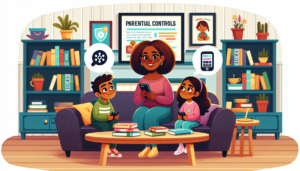Key Takeaways:
| Takeaway | Description |
|---|---|
| Smartphone Addiction Stats | Over 75% of people admit to smartphone addiction, with 45% of teens online “almost constantly.” |
| The Impact of Phubbing | Phubbing, or phone snubbing, harms relationships; it’s essential to address this issue in family dynamics. |
| Create Device-Free Zones | Encourage family bonding by designating times when devices are placed in a basket, fostering distraction-free moments. |
| Enjoy Devices Together | Utilize apps and games to connect with family members, creating shared experiences on smartphones and tablets. |
| Get Outdoors with Geocaching and Pokémon | Use smartphones for outdoor fun, like geocaching and Pokémon Go, combining technology with nature exploration. |
| Screen Time Challenge | Motivate your family to reduce screen time through friendly competition, tracking, and rewards, with Safe Lagoon’s help. |
How many people in your home are addicted to their phones?
According to recent statistics, more than 75% of people consider themselves addicted to their smartphones. When it comes to teens, 45% say they are on the internet “almost constantly.”
We all know what it’s like to try to connect with somebody who is distracted by their device. It’s not easy! There’s actually a term for this kind of situation: phubbing. It stands for “phone snubbing.” Besides being annoying and a little hurtful, numerous studies have shown that phubbing actually has serious effects on relationships, causing conflict between couples and between parents and their children.
Eliminating all instances of phubbing in your family isn’t a realistic goal, but working toward less phubbing and more family bonding in your house is possible. Use these 4 great device habits to keep your family close and get started!
Create Device-Free Zones.
Did you know that Americans check their phones nearly 100 times each day? You’ve probably noticed your children checking their phones at dinner, in the car, while you’re talking to them about their homework . . . it can seem like they’re always checking their phones!
Try this remedy: Grab a small basket and ask that all family members put their devices in the basket during certain times of the day. (This includes smart watches, too!) Reserve these times for “family time.” By putting the devices in the basket, family members won’t be tempted to sneak a click.
Many families use this strategy to keep breakfast or dinner device-free. If all family members don’t eat at the same time, designate another device-free time during the day when you’re all together. This could be 8 p.m. when everybody is home from work and done with extracurricular activities. It could be as simple as 20 minutes dedicated to your family catching up.
Enjoy Your Devices Together.
Make an effort to use your devices to connect with your family members. Playing apps is a great way to do this. Instead of playing games on the kitchen table, you can play games on your smartphone or tablet. There are a few ways to do it. In some games, everybody comes together and uses just one smartphone. In others, each family member can set up their own account and then play together, each on their own phone. There are apps for classic games like Scrabble, Yahtzee, and Uno. Plus, you can find new games for all ages like Ticket to Ride and 5 Second Guess.
Use Your Devices to Get Outside.
One consequence of constantly using our devices is that we stay indoors for hours on end. Show your family that you can have fun on your devices while soaking up some sunshine!
Geocaching is like a modern-day treasure hunt. People all over the world have hidden small “caches”, like treasure boxes, and posted the geographical coordinates of the caches online. You can look up caches near you using geocaching.com, input the coordinates into your smartphone’s mapping system, and follow the directions. You can use their app to find caches, too.
Pokémon Go is a popular app among teens, and it encourages moving around outdoors, too. In this game, your smartphone simulates real-life Pokémon, and your mission is to “catch” them. Go anywhere and Pokémon will appear!
You could also venture outside with your devices at night. Have all your family members download a stargazing app and spend some quiet moments finding constellations.
Create a Screen Time Challenge.
Who can spend the least amount of time on their electronic devices? It’s an unusual challenge, but it’s one that could definitely motivate your family to decrease screen time.
Start by setting a timeframe for your challenge. If your family is fairly addicted, start with a week-long challenge. Then, have everybody track their daily screen time on a piece of paper or whiteboard that’s posted in a highly visible place, perhaps in the kitchen. And don’t forget to include a prize for the winner!
Did you know that Safe Lagoon can help with this screen time challenge? With the app, you can schedule screen time and understand how your child is spending time online. Check out our blog for more helpful tips!





